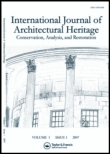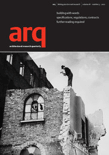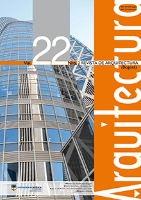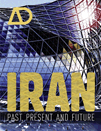
Nexus Network Journal
Scope & Guideline
Innovating Connections in Visual Arts and Architecture.
Introduction
Aims and Scopes
- Interdisciplinary Research:
The journal emphasizes the intersection of architecture and mathematics, fostering studies that explore how mathematical concepts can inform architectural design and construction. - Computational Design and Fabrication:
A core focus is on computational methodologies, including parametric design, generative algorithms, and robotic fabrication, which are increasingly vital in contemporary architectural practices. - Historical and Theoretical Analysis:
The journal publishes works that analyze historical architectural practices and their mathematical foundations, providing insights into the evolution of architectural forms and techniques. - Geometric and Structural Innovations:
Research that investigates new geometric configurations and structural innovations is a significant theme, particularly in the context of optimizing material use and enhancing structural performance. - Cultural and Contextual Studies:
The journal also addresses cultural and contextual factors in architectural design, exploring how local traditions and historical contexts influence contemporary architectural solutions.
Trending and Emerging
- Generative and Algorithmic Design:
There is an increasing focus on generative and algorithmic design processes, utilizing computational tools to create complex architectural forms and optimize design solutions. - Integration of AI and Machine Learning:
Recent publications highlight the integration of artificial intelligence and machine learning techniques in architectural design and analysis, showcasing their potential to enhance creative processes and decision-making. - Sustainability and Environmental Performance:
A growing emphasis on sustainability and environmental performance in architectural design is evident, with research exploring how computational methods can contribute to eco-friendly building practices. - Digital Fabrication Techniques:
Emerging themes include advanced digital fabrication techniques, such as 3D printing and robotic construction methods, which are reshaping how architectural components are designed and realized. - Cultural Contextualization in Design:
There is a trend towards exploring the cultural contextualization of design, where researchers examine how local traditions and cultural narratives can inform contemporary architectural practices.
Declining or Waning
- Traditional Craftsmanship:
There seems to be a decrease in papers focused exclusively on traditional craftsmanship techniques, as the journal shifts towards embracing digital and computational methodologies. - Static Geometric Analysis:
Research that emphasizes static or purely geometric analyses without considering dynamic or computational aspects may be waning, as the field increasingly values interactive and adaptable design solutions. - Historical Preservation Techniques:
While historical analysis remains important, specific discussions on preservation techniques that do not incorporate modern technology or methodologies may be less frequently featured. - Isolated Case Studies:
The journal appears to be moving away from isolated case studies that do not connect to broader theoretical frameworks or contemporary issues in architecture and mathematics. - Non-Parametric Design Approaches:
There is a noticeable decline in interest in non-parametric design approaches, with a stronger focus on parametric and algorithmic design methodologies as the preferred avenues for exploration.
Similar Journals

IN BO-Ricerche e Progetti per il Territorio la Citta e l Architettura
Documenting and innovating the architectural narrative of our cities.IN BO-Ricerche e Progetti per il Territorio la Citta e l Architettura, published by the Department of Architecture at the University of Bologna, serves as a crucial conduit for scholarship in the fields of architecture, urban studies, building and construction, and visual arts. With its commitment to open access since 2008, this journal ensures that innovative research is accessible to a broad audience, fostering collaboration and advancement within these disciplines. Although it currently holds a Q4 ranking in various categories, including Architecture and Urban Studies, it plays a pivotal role in contextualizing contemporary challenges faced in urban development and architectural practice, thereby encouraging critical discourse. The journal publishes original research findings, case studies, and theoretical discussions aimed at enhancing the understanding of the interactions between built environments and social dynamics. Engaging researchers, professionals, and students alike, IN BO is dedicated to not only documenting but also shaping the future of urban and architectural landscapes in Italy and beyond.

Fabrications-The Journal of the Society of Architectural Historians Australia and New Zealand
Connecting Past and Present Through Architectural InsightFabrications - The Journal of the Society of Architectural Historians Australia and New Zealand is a vital scholarly platform that explores the rich interplay between architecture and its historical context within the Australasian landscape. Published by Routledge Journals, Taylor & Francis Ltd, this journal serves as a crucial resource for researchers, professionals, and students in the fields of architectural history, urban studies, and visual arts. With an ISSN of 1033-1867 and an E-ISSN of 2164-4756, Fabrications has received recognition for its quality, placing in the Q4 category in Urban Studies and Q2 in Visual Arts and Performing Arts as of 2023. This journal not only welcomes innovative research articles but also encourages the exploration of New Zealand and Australian cultural heritage through diverse architectural narratives. With publications spanning significant years since its inception in 1989, Fabrications continues to provide an open forum for dialogue and discovery, catering to the academic and professional community's growing interest in architectural narratives through a regional lens.

ARCHITECTURAL RECORD
Shaping the Future of Design and DiscourseARCHITECTURAL RECORD, published by McGraw Hill Inc, stands as a vital resource in the field of architecture and design, offering insightful perspectives and critical analyses that cater to architects, designers, and academia alike. With an ISSN of 0003-858X, this prestigious journal has been a cornerstone for the architectural community, providing a blend of contemporary practices and theoretical frameworks since its inception. Although it is not currently available through Open Access, its rich content contributes to the ongoing dialogue in both the Visual Arts and Performing Arts, as well as Engineering and Architecture disciplines. The journal's historical impact can be seen through its wide readership and influence in shaping architectural discourse, making it a highly regarded publication for professionals and students in the field. As a beacon of innovative practices, ARCHITECTURAL RECORD continues to inspire and educate, even despite its coverage discontinuation in Scopus since 2018.

International Journal of Architectural Heritage
Championing the Art of Conservation and Architecture.The International Journal of Architectural Heritage is a premier publication dedicated to the multidisciplinary fields of architecture, conservation, and visual arts. Published by TAYLOR & FRANCIS INC, this journal serves as a vital platform for scholars and practitioners who aim to advance knowledge in the preservation of cultural heritage and architectural innovation. With an impressive impact factor reflecting its critical acclaim, including rankings in the top quartile (Q1) across multiple categories in 2023, the journal is recognized as a key resource in Arts and Humanities, particularly in Visual Arts and Performing Arts and Conservation. Since its inception in 2007, the journal has consistently provided rigorous peer-reviewed research, offering enriching insights and fostering collaborations amongst students, researchers, and professionals committed to the future of architectural heritage. As it continues to influence the field through its diverse and impactful contributions, readers can expect to engage with leading-edge studies that not only illuminate current trends but also inspire innovative practices in safeguarding architectural legacies.

arq-Architectural Research Quarterly
Elevating Knowledge in Architectural Researcharq-Architectural Research Quarterly, published by Cambridge University Press, is a leading journal in the fields of architecture, visual arts, and performing arts. With an ISSN of 1359-1355 and an E-ISSN of 1474-0516, the journal has successfully captured the essence of architectural research since its inception in 1995. Recognized for its rigorous academic contributions, it currently holds a Q4 quartile in Architecture and a Q3 quartile in Visual Arts and Performing Arts as of 2023, reflecting its commitment to advancing knowledge within these disciplines. While it does not offer Open Access, it remains a crucial resource for scholars, professionals, and students seeking to explore innovative ideas and practices in architecture and the arts. The journal features a diverse range of articles that foster interdisciplinary dialogue, making it an indispensable platform for those interested in shaping the future of architectural discourse.

Bulletin KNOB
Exploring Cultural Narratives Through TimeBulletin KNOB, published by the KONINKLIJKE NEDERLANDSE OUDHEIDKUNDIGE BOND-KNOB, is a reputable Open Access journal that has been disseminating knowledge since 1899, with a continued commitment to making research accessible to all. Based in the Netherlands, this journal provides a platform for scholarly articles that span the fields of Conservation, History, and the Visual Arts and Performing Arts. With its 2023 Scopus rankings placing it in the top quartiles within its category, Bulletin KNOB is recognized for its significant contribution to the advancement of these disciplines. Researchers, professionals, and students alike are encouraged to engage with the journal's diverse content that bridges historical narratives with contemporary practices, fostering a deeper understanding of cultural heritage. The journal’s commitment to excellence is further reflected in its Q3 and Q4 quartile rankings, making it an essential resource for anyone dedicated to the study of the arts and humanities.

Revista de Arquitectura-Bogota
Leading the Dialogue in Architectural InnovationRevista de Arquitectura-Bogota is a premier academic journal dedicated to the field of architecture, published by the esteemed Universidad Católica de Colombia, Facultad de Diseño. Since its inception in 1999, this Open Access journal has provided a vital platform for the dissemination of innovative research and critical discourse in architectural studies. With its commitment to the principles of open accessibility, the journal ensures that its diverse range of scholarly articles, case studies, and reviews are readily available to researchers, professionals, and students globally. The journal aims to foster collaboration and dialogue among architects, urban planners, and educators by publishing high-quality content that reflects contemporary issues and advancements in architecture. As an influential resource in the architectural community, Revista de Arquitectura-Bogota plays a crucial role in shaping the future of architectural practice and education in Latin America and beyond.

Journal for Geometry and Graphics
Charting New Territories in Geometry and Applied GraphicsThe Journal for Geometry and Graphics, published by HELDERMANN VERLAG, is a recognized platform dedicated to advancing the fields of geometry and graphics, intersecting with applied mathematics and psychology. With its origins dating back to 1997 and a comprehensive coverage extending up to 2023, the journal provides a critical space for the dissemination of innovative research and theoretical advancements. Although currently positioned in the Q4 quartile across multiple categories, including Applied Mathematics, Applied Psychology, and Geometry and Topology, aspiring authors and researchers are encouraged to submit their works, as the journal plays an essential role in fostering discourse and applications in these disciplines. Moreover, it provides a crucial outlet for interdisciplinary studies that bridge mathematical theory with practical graphical applications. Researchers, professionals, and students alike benefit from the insights and findings published herein, which ultimately contribute to the evolving landscape of geometric thought and graphical representation.

ARCHITECTURAL DESIGN
Connecting Theory and Practice in ArchitectureARCHITECTURAL DESIGN, a leading journal published by Wiley Periodicals, Inc., serves as a vital platform for discourse in the fields of architecture and visual arts. With an ISSN of 0003-8504 and an E-ISSN of 1554-2769, this esteemed publication offers comprehensive insights into contemporary design practices and emerging architectural theories. Established in the United States and continuously evolving from 2002 to 2024, the journal has secured a prominent position with a Q3 status in Architecture and an impressive Q1 ranking in Visual Arts and Performing Arts as of 2023. Its Scopus rankings further affirm its relevance, with a percentile ranking of 82nd in the Visual Arts category. Although it does not currently offer Open Access options, the journal remains dedicated to disseminating high-caliber research and innovative design strategies that engage a diverse readership of researchers, professionals, and students alike. The contributions published within its pages are instrumental in shaping the discourse around architecture, making ARCHITECTURAL DESIGN an indispensable resource for anyone passionate about the built environment.

Ra-Revista de Arquitectura
Fostering innovation through critical dialogue.Ra-Revista de Arquitectura is an esteemed open-access journal published by UNIV NAVARRA, SERVICIO PUBLICACIONES in Spain, dedicated to the fields of architecture and the visual arts. With an ISSN of 1138-5596 and an E-ISSN of 2254-6332, this journal aims to foster a critical dialogue among scholars, practitioners, and students by offering original research, reviews, and case studies that challenge conventional architectural paradigms and inspire innovation. Since transitioning to an open-access model in 2012, Ra has expanded its reach, allowing free access to knowledge that resonates within both academic and professional communities. Although the journal is currently ranked in Q4 in its respective categories, it remains a vital platform for emerging voices and advancements in the architecture and visual arts disciplines. Researchers can find valuable insights that push the boundaries of both theory and practice. The journal is part of a vibrant academic tradition, contributing to a deeply reflective cultural heritage, and it invites contributors from diverse backgrounds to submit their works for consideration.